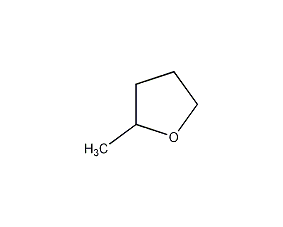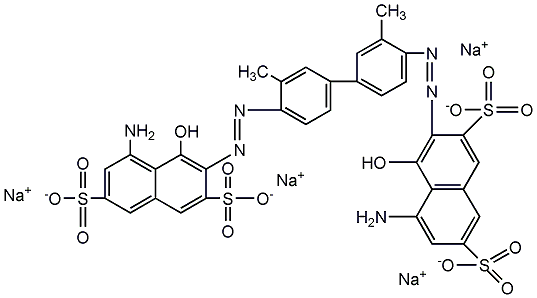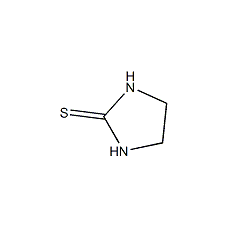
Structural formula
| Business number | 02B6 |
|---|---|
| Molecular formula | C5H10O |
| Molecular weight | 86.13 |
| label |
Tetrahydro-2-methylfuran, 2-Methyltetrahydropran, Tetrahydro-2-methylfuran, Tetrahydrosilvan, Ether and acetal solvents, Heterocyclic compounds |
Numbering system
CAS number:96-47-9
MDL number:MFCD00005367
EINECS number:202-507-4
RTECS number:LU2800000
BRN number:102448
PubChem number:24865929
Physical property data
1. Properties: colorless liquid with an ether-like odor.
2. Relative density: 0.8552
3. Freezing point (ºC): -136
4. Melting point (ºC): -137.2
5. Boiling point (ºC): 80
6. Refractive index (25ºC): 1.4025
7. Flash point (ºC): -11
8. Solubility: Soluble in water, the solubility in water increases with the decrease of temperature, and is easily soluble in organic solvents such as ethanol, ether, benzene and chloroform.
9. Refractive index at room temperature (n20): 1.405921
10. Critical temperature (ºC): 263.85
11. Critical pressure (MPa): 3.76
12. Critical density (g·cm-3): 0.322
13 . Critical volume (cm3·mol-1): 267
14. Critical compression factor: 0.225
15. Eccentricity factor: 0.264
Toxicological data
1. Skin/eye irritation: Standard Dresser test: rabbit eye contact, 500mg/24HREACTION SEVERITY, slight reaction; 2. Acute toxicity: rat inhalation LC50: 6000ppm/4H; rabbit skin contact LD50: 4500mg/kg;
Ecological data
General remarks
Water hazard class 1 (German Regulation) (self-assessment via list) The substance is slightly hazardous to water.
Do not allow undiluted or large amounts of product to come into contact with groundwater, waterways or sewage systems.
Do not discharge materials into the surrounding environment without government permission.
Molecular structure data
1. Molar refractive index: 24.76
2. Molar volume (cm3/mol): 99.7
3. Isotonic specific volume (90.2K ): 224.1
4. Surface tension (dyne/cm): 25.3
5. Dielectric constant:
6. Dipole moment (10-24cm3):
7. Polarizability: 9.81
Compute chemical data
1. Reference value for hydrophobic parameter calculation (XlogP): 1
2. Number of hydrogen bond donors: 0
3. Number of hydrogen bond acceptors: 1
4. Number of rotatable chemical bonds: 0
5. Number of tautomers: none
6. Topological molecule polar surface area 9.2
7.Number of heavy atoms: 6
8. Surface charge: 0
9. Complexity: 43.2
10. Number of isotope atoms: 0
11. Determine the number of atomic stereocenters: 0
12. Uncertain number of atomic stereocenters: 1
13. Determine the number of chemical bond stereocenters: 0
14. Number of uncertain chemical bond stereocenters: 0
15. Number of covalent bond units: 1
Properties and stability
Avoid exposure to air. Avoid contact with strong oxidants and humid air. It is easily oxidized in the air and can easily cause combustion when exposed to open flames or high heat.
The toxicity is similar to that of 2-methylfuran, see 2-methylfuran for details.
?
Storage method
1. Store in a cool, ventilated warehouse. Keep away from fire and heat sources. The storage temperature should not exceed 30?. The packaging must be sealed and must not come into contact with air. They should be stored separately from oxidants, etc. and avoid mixed storage. Use explosion-proof lighting and ventilation facilities. It is prohibited to use mechanical equipment and tools that are prone to sparks. The storage area should be equipped with emergency spill treatment equipment and suitable containment materials.
2. Packed in iron drums. Store in a cool, ventilated, dry warehouse. Fireworks are strictly prohibited. Handle it with care when transporting, and do not turn it upside down to avoid collision. Store and transport according to regulations for flammable and toxic substances. Packed in iron drum, net weight 170kg/drum.
Synthesis method
Originated by catalytic hydrogenation of 2-methylfuran. When the catalytic hydrogenation reaction uses a palladium chloride catalyst, the main product is acetyl propyl alcohol (see 00420), but the by-product 2-methyltetrahydrofuran can also be recovered.

Purpose
It is used as a solvent for resins, natural rubber, ethyl cellulose and chloroacetic acid-vinyl acetate copolymer; it is also a raw material in the pharmaceutical industry and can be used in the synthesis of anti-hemorrhoidal drugs such as primaquine phosphate.
extended-reading:https://www.bdmaee.net/wp-content/uploads/2021/05/139-4.jpgextended-reading:https://www.newtopchem.com/archives/category/products/page/134extended-reading:https://www.bdmaee.net/cas-23850-94-4/extended-reading:https://www.bdmaee.net/pc-cat-t9-catalyst-nitro/extended-reading:https://www.bdmaee.net/fascat4352-catalyst-arkema-pmc/extended-reading:https://www.bdmaee.net/polyurethane-monosodium-glutamate/extended-reading:https://www.bdmaee.net/fentacat-f14-catalyst-cas112945-86-2-solvay/extended-reading:https://www.bdmaee.net/polyurethane-catalyst-smp/extended-reading:https://www.bdmaee.net/wp-content/uploads/2023/02/1-2-1.jpgextended-reading:https://www.cyclohexylamine.net/high-quality-18-diazabicycloundec-7-ene-cas-6674-22-2-dbu/






